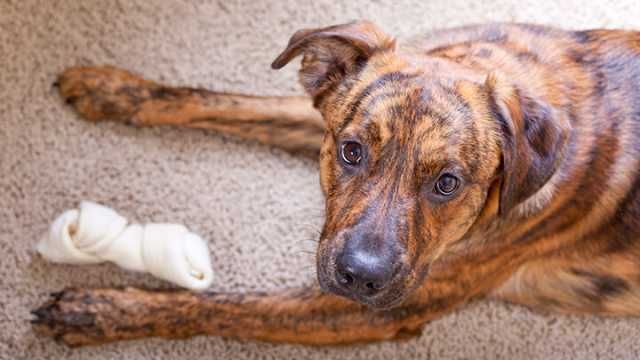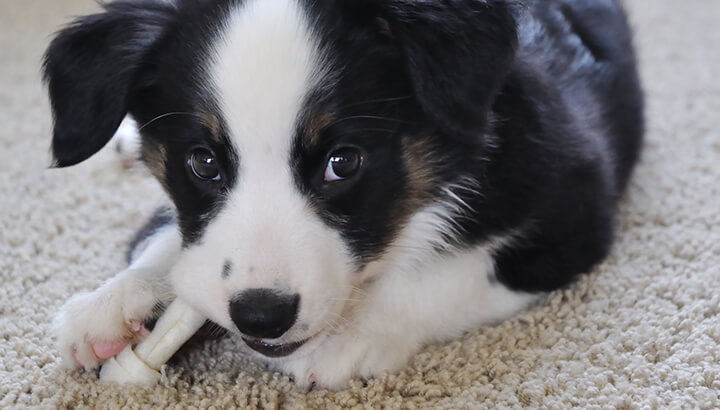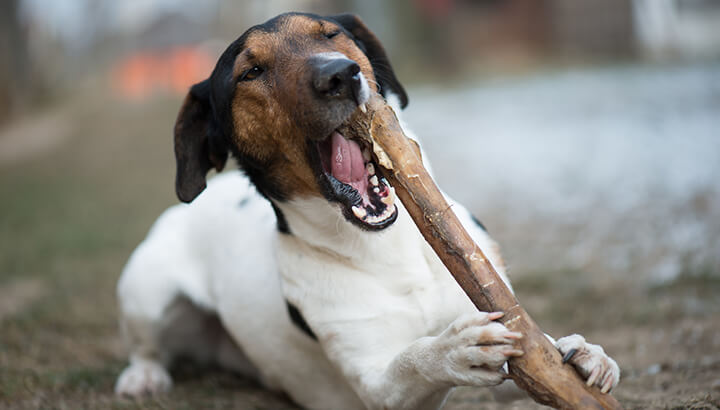
Most dogs, as any dog owner can tell you, are avid chewers. Many dogs can while away hours of the day chewing happily on a single bone. When left with nothing to chew, your dog may start on furniture, shoes, corners of walls… you name it. This, of course, is no good for your dog or your home. Giving your pooch something to chew on is a must.
One of the most popular dog bones on the market is rawhide. Dogs love them, they’re pleasing to the eye in their perfect bone shapes and they don’t smell bad. What could be wrong? Unfortunately, a lot.
The primary danger
While there is a long list of problems with rawhide (more on those in a minute), I’d say the most pressing danger is that dogs can choke — and even die — from ingesting shards of it. Dogs often get excited when they chew. And if they swallow a big enough piece, it can get stuck in their throat or their digestive tract. If this happens, it requires an emergency surgery. This, of course, means a lot of pain, worry and steep vet bills. In a worst case scenario, this sort of blockage can end your dog’s life.
A chemical cocktail in a dog chew

Although the name “rawhide” makes it sound like these chews are natural, the process used to make them is anything but. Once you hear about how rawhide is made, I doubt you’ll want to buy one for your dog ever again.
It starts with a piece of the inner portion of a cow hide (the outer portion is made into leather). The hide section is then doused in preservative chemicals so that it does not spoil. Then, it is soaked in a solution (which often includes lye) to remove the hair and fat which may cling to the hide. After that, it is soaked in yet another chemical solution, to help it split into layers. We’re not done yet — the hides are then bleached or doused in hydrogen peroxide (that’s the reason they don’t smell).
If that weren’t enough, if the hides you purchase are colored or flavored, they likely contain a few of any number of artificial colorings and flavorings. These types of dog chews are able to bypass FDA regulations if they do not have any “reference to nutritional value” because they are not in the same category as a pet food. So, virtually any additive could potentially be used in them.
Bonus: When testing rawhide, researchers found toxic chemicals such as arsenic, formaldehyde and lead.
Other dangers
Yes, there are indeed more dangers. Because rawhide is so heavily processed and it goes through so many manufacturing steps, it may be contaminated with E. coli, salmonella or other toxic chemicals. This can make your dog sick. It could even make you and your family sick if you touch the rawhide and do not wash your hands before eating, for example.
Some dogs are also allergic or have sensitive reactions to rawhide and the products used to create it. This can lead to stomach upset and other potential allergic reactions.
What to get your dog instead

You know your dog needs to chew. It’s natural for them and it’s also good for their jaws and teeth. But, you don’t want to get dangerous, chemical-laden rawhide. The following are a few much healthier alternatives:
- Raw bones: Make sure they’re natural, without any additives in the mix. Check with your vet to determine the type that is right for your dog. Also, make sure you found the bones refrigerated or frozen.
- Bully sticks: Again, make sure there are no artificial colors or flavors added.
- Duck feet: Sounds weird, but dogs love ‘em. Plus, they’re natural — assuming that they haven’t had additives pumped in. Always know your source and your ingredients.
What do you give your dog to chew on? Please share your experiences and your pup’s favorites!
– Tanya Mead

